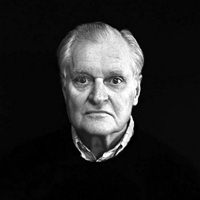Paradoxes and Oxymorons by John Ashbery: Summary and Analysis
Paradoxes and Oxymorons composed by famous postmodern American poet John Ashbery was written in 1979. It was first published in the Times Literary Supplement and later in his collection of poems Shadow Train in 1981.

John Ashbery (1927-2017)
The speaker, in the first stanza, of the poem directly addresses the reader and says that the ‘poem is concerned with the language.’ The speaker states that the language in the poem is talking to us (the reader). It wants our attention, but we pretend to play or do something else to avoid it. We have the poem and we can interpret the language of the poem according to our perception and the situation. But, sadly and paradoxically, we can’t have control over the poem, so the speaker says ‘you have it but you don’t have it.’ This means that we have the language in the poem, but we are unable to express the essence of the poem and the exact meaning of the poem what the author had intended to. So we miss it and it also misses us.
In next stanzas, the speaker shows the relationship between the author and the poem on the basis of Roland Barthes’s theory of ‘The Death of the Author’. As per this theory, once a text is written, it is free from the grip of the author and the authorship dies immediately at the moment. The first line of the second stanza says, ‘The poem is sad because it wants to be yours, and cannot.’ The poem wants to be in the control of the author, but sadly it cannot. The writer loses its control over the poem and the poem is free for the different interpretation by different readers and critics. The play of the words and the phrases, their intended meaning lose their exactness in the steam and the chatter of the typewriters. The speaker in the concluding lines says that language has a playful nature, it pretends that it is with us, but the moment we express it in the poetic form, it again slips away from the author and adopts a different attitude of different reader.
In the final line, there is an ironic twist when the speaker says ‘the poem is you.’ i.e. poetry is nothing but the manifestation of the self. Every individual is a poem in oneself and the individual suffers from the contradictions, paradoxes, tensions and oxymoron. One tries to represent all those things in the poem. Because each person is undergoing conflict, it is reflected in the poem.
This poem is related to the writing process and especially it examines what happens when we are writing. Every poet does have an idea in the mind. One wants to express those ideas through the poem. But the difficult thing is that they can never express what they want to express. So the poet says "You have it but you don't have it." We feel that we have expressed, but we cannot express absolutely. The words and language are insufficient for the expression of the poet’s ideas. Every poet brings different words and phrases to express the meaning. When these phrases are brought together they lead to paradoxes, contradictions and oxymoron. In this respect everything is nothing but the play of oxymoron and paradoxes. Therefore, the poet defines poetry as "bringing a system of them into play".
When we read this play of words and phrases, obviously a text becomes open-ended. Because of the paradoxes and contradictions, multiple reading becomes possible. Writing itself gives birth to open-endedness. But actual idea is not represented in the poem. We approach the idea from one or the other corner; only the paradox is reflected. Therefore, the speaker says ‘you have it but you don’t have it.’ We feel that we have expressed, but can never do what we want to do. Only the paradox is reflected.
Once the writing goes to the readers, they approach it from their own vantage point. Some may approach from one angle and others may approach from another angle. Since the poem is the play of paradoxes, it welcomes all approaches. Eventually it becomes open ended. Language is plain and playful, but the meaning is contradictory. This contradictory meaning is nothing but the reflection of the self.
The poem does not follow exactly any formal structure; some lines follow hexameter, while others follow end rhyme and some others have accentual verse. This vague structure supports the postmodern ‘incredulity toward metanarratives’. The language is just a mask for the knowledge, and this expressed language is not self-sufficient but relative and depended.
Related Topics
Brute Images: Summary and Analysis
Melodic Trains: Summary and Analysis
 |
bachelorandmaster.com |